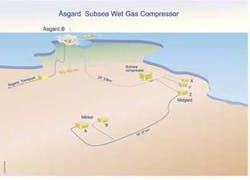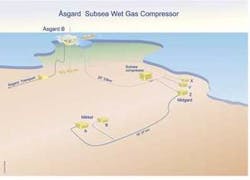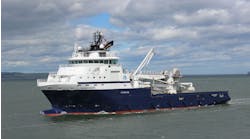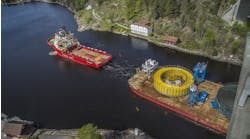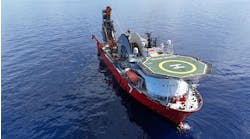Savings up to $62 million at Tyrihans
null
Nick Terdre, Contributing Editor
Subsea processing is critical to Statoil’s long-term plans both on the Norwegian continental shelf (NCS) and in its other target offshore sectors. The company is a subsea operator, with close to 300 subsea production wells under its control on the NCS and interests in subsea and floater developments in areas such as West Africa, Brazil, and the Gulf of Mexico.
In the Norwegian sector it is aiming for average recovery of 55% from subsea wells, compared with a current rate of around 45%. A wide-ranging program of technology development known as SIOR (subsea improved oil recovery) has been established to pursue this goal, of which subsea processing forms part. The company’s subsea department in Stavanger is working on system development in association with the research center in Trondheim.
Statoil has deployed subsea booster pumping on Lufeng 22-1 offshore China since this field came onstream in 1998. Subsea pumping has also influenced its decision to extend production on Lufeng beyond the originally scheduled term.
The company now plans three further subsea processing applications over the next five years:
- Installation of the world’s first commercial-scale subsea separation system on Tordis in the North Sea in 2007
- Subsea raw water injection system on Tyrihans field in the Norwegian Sea in 2009 (as with Tordis, this project was approved by the license partners in 2005)
- Subsea gas compression system on Åsgard in the Norwegian Sea in 2011.
Other potential applications of subsea gas compression could include the giant Troll field, midway through the next decade, Snøhvit in the Barents Sea around 2020, and possibly remote/ Arctic developments.
Production benefits
In each case, subsea processing appears to offer significant benefits compared with other improved recovery solutions. Subsea separation on Tordis, in production since 1994, should allow management of increasing volumes of produced water without the need for additional water-handling equipment on the host platform. It will also allow a greater proportion of the pipeline’s capacity to be used for transporting hydrocarbon, rather than water. As part of a two-pronged improved oil recovery (IOR) project on Tordis, subsea separation will contribute an estimated 19 MMbbl to additional production, also helping to extend output by about five years.
On Tyrihans, Statoil expects a substantial gain in recovery through use of water injection to maintain reservoir pressure, with an injection rate of 88,000 b/d from start-up in 2009. Subsea injection of raw sea water should bring savings of $31 to $61.9 million, according to Torstein Vinterstø, the subsea manager for Tyrihans, compared with the alternative topsides investment on a host platform.
On the Åsgard field complex, where reservoir pressure is declining, subsea gas compression will allow an additional 30-40 bcm from both the Midgard and Mikkel fields. The scheme is considered more beneficial than topside solutions on the host Åsgard B platform, such as reducing the inlet pressure or installing compression facilities.
Marinization issues
There is no intrinsic reason why processing operations performed at the surface - pumping, separation, dehydration, filtration, compression, and so on - cannot be transferred to the seabed, according to Knut Nordstad, senior discipline adviser who is also responsible for subsea processing at Statoil’s research center in Trondheim. But the requirements for carrying out such operations on the seabed are very different. Equipment and systems must be marinized to make them suitable for operation in the marine environment, for example by packaging them to prevent ingress of sea water.
For various other reasons, technology developed for use at the surface may not be suitable subsea. Processing equipment and power supply are the two main areas demanding new technological solutions.
Subsea equipment, however, is difficult and costly to access for maintenance purposes, and in the event of malfunction. All equipment must therefore be highly reliable, and designed in a modular form so that critical parts are retrievable separately for maintenance or repair purposes. In addition, redundancy helps avoid system failure when malfunction of a critical component or sub-system occurs.
Supply and distribution of power to run the equipment is another major challenge, and one that becomes greater as the power requirement and/or transmission distance increases. Sea water must not come into contact with electrical parts when in operation, even though the power supply has to be connected to the consumers subsea. And once power supply and/or distance pass critical values, solutions are also required firstly for transmitting high-voltage power over long distances, and then converting it to lower-voltage power and distribution on the field.
Statoil has adopted an active approach to developing subsea processing technology. Its involvement began with work on multiphase pumps under the Poseidon program in the early 1990s, followed by development of both single-phase and multiphase subsea pumps. This came about via cooperation with Norwegian pump suppliers Framo Engineering and Aker Kvaerner.
Subsea separation investigations were initiated by the Norne Technology Project in 2002, which included several sub-projects funded by the government’s Demo 2000 program. This work also brought together the Norwegian subsea processing fraternity of Aker Kvaerner, ABB Offshore Systems (now Vetco Gray), and FMC Kongsberg Subsea.
The new Tordis project, based on subsea separation, produced water injection and sand management, builds on the outcome of the Norne qualification program, which also evaluated subsea injection of raw sea water, laying much of the groundwork for the Tyrihans system.
With respect to subsea compression, a strategic discussion took place within the company in 2004 on whether to take an active role or wait for other parties to take the lead, Nordstad says. Statoil opted for an active role, one reason being that the technology development could be undertaken in steps.
The projects-in-hand show a gradual increase in both step-out distance and power requirement, which makes the technological advance from one to the next more manageable. Step-out distances increase from less than 1 km on Lufeng to about 12 km on Tordis, 35 km on Tyrihans and 40-50 km on Åsgard. The power requirement grows from 1.5 MW on Lufeng to 5 MW on Tordis, 6 MW on Tyrihans, and 12 MW on Åsgard.
Subsea building blocks
Subsea processing consists of a number of basic building blocks, which occur in different combinations in the different forms of subsea processing, Nordstad says. Subsea separation on Tordis, for example, makes use of separation (both liquid/gas and oil/water), sand removal, and pumping. Subsea water injection on Tyrihans involves filtration, including sand removal, and pumping.
The subsea gas compression system as envisaged for Åsgard involves separating liquids from gas and separate pressure increase of these two phases. Sand control is also required to avoid the adverse effects of sand on the pump. Common tasks in different forms of subsea processing may be performed by the same equipment. For example, the same multiphase pump used in the Tordis separation system could be used for liquid pumping in the Åsgard gas compression system, and the same pump used for pumping water into a disposal well on Tordis could be adopted for pumping water into the injection well on Tyrihans.
Power concerns
While the subsea separation system for Tordis is fully qualified, there is some qualification still to be done on the power side for Åsgard, specifically on the wet mateable connectors and transmission of high frequency power, Nordstad says.
Tyrihans is similar to Tordis in its power requirement, though the step-out, at 35 km compared with 12 km, is three times as long. The main challenges consist in preventing the ingress of sea water into either the motors of the two pumps or the electrical system.
For the Åsgard subsea compression project, a high-throughput capacity of 10-18 MMcm/d of gas is the aim, which necessitated two 6- to 8-MW compressor units. However, Statoil plans to simplify the process by locating the frequency converter on the Åsgard B platform - this will allow the subsea technology development to concentrate on the subsea compressor.
To run the compressor at different speeds, AC power will be converted first to DC power, then back to AC at different frequencies on the platform, and finally transmitted to the compressor.
Various joint studies with vendors have concluded that this is a viable solution, Nordstad says. However, pending final qualification of high-frequency power transmission, work will be carried out on qualifying a subsea frequency converter for Åsgard.
Two-stage concept
Statoil has selected a two-stage concept for subsea compression - gas and liquids are first separated and then submitted to a boosting process, the liquids through a pump and the gas through a compressor. They are then recombined in a single flow.
For subsea use a compressor must be very robust compared with a surface unit, says Nordstad. In a surface application, the gas can be cleaned before being fed into the compressor. But in a subsea context, the compressor has to be capable of handling ‘dirty’ gas, for even though the intention is to put the well stream through a scrubber upstream of the compressor, this will only partially clean it.
On top of that, the system must have a very low maintenance requirement. The most common type of compressor used in surface applications is unsuitable, as it has components requiring frequent maintenance, such as seals, gearbox, couplings, and lubrication system.
Statoil’s selected compressor solution is a centrifugal wet gas model with a high-speed motor (no gear or couplings), magnetic bearing (no lube oil system) and integrated motor/compressor (no seals). While at the surface, air or clean, filtered gas is available to cool the motor; for the subsea application dirty gas will be used. The centrifugal gas compressor is mature technology, with the additional benefit that it is capable of handling high gas volumes.
A further benefit of the integrated motor/compressor is that it is a compact unit compared with non-integrated systems, reducing the footprint of the subsea compression station and facilitating installation.
Numerous vendors are developing integrated motor/compressor models with power ratings up to 12.5 MW. Several have prototypes awaiting testing this year.
The main hurdles involve making the compressor robust enough for well stream service and marinizing it, Nordstad says. Engineering and design work is under way, and testing of critical components - essentially the motor itself and the cooling system - will take place later this year in cooperation with vendors.
Compressor tests
Next year an extensive test program for the motor/compressor, including shallow water tests, is due to start at Statoil’s K-Lab laboratory in western Norway. This program should enable the company to identify one or more compressor models with the reliability needed for subsea operation. Further shallow water tests of the complete subsea compressor system will be carried out in 2010-11.
If all goes according to plan, the full-scale subsea compression system will then be installed at Åsgard in summer 2011. The system will undergo testing to allow Statoil to gain operational experience before it is brought into full use as part of the production system.
To give an idea of the compression spread’s likely dimensions, the solution proposed by one contractor, when assembled as an integrated unit on a foundation structure, measures 20 m x 20 m and rises 11 m above the sea floor. With an anti-trawl protection structure installed on top, the length would be 43 m and the weight of the complete unit about 1,200 tons.
Statoil also intends to use the same low-maintenance compressor solution on platforms to improve gas and condensate recovery by lowering wellhead pressure. In such a case compression will be required to boost the gas export stream.
Future compression projects
Subsea compression is being transferred from Statoil’s R&D project portfolio to the ordinary project development portfolio. Qualification of the Åsgard subsea gas compression technology will open the way to further applications. One possible application is on Troll, in connection with planned stages of further development.
Compression facilities were installed on the Troll A gas platform last year to compensate for falling reservoir pressure, and more compressor units will be installed in the period 2011-16. The combination of compression at Troll A and the use of subsea gas compression could be an important building block in the Troll field production horizon for the optimization of gas recovery, and will be evaluated as part of the Troll future development plan.
Subsea gas compression is also likely on Snøhvit in the Barents Sea from around 2020, again to compensate for declining reservoir pressure. Here it provides an attractive alternative to installing a dedicated compression platform. However, the challenges associated with delivering large amounts of power - around 20-40 MW - over a long distance will have to be surmounted, for Snøhvit lies around 140 km from its shore terminal.
This will also probably apply to exploitation of remote and arctic gas reserves. Snøhvit has been developed as a closed system consisting of subsea facilities tied back directly to land. A similar philosophy is likely to be applied for finds made far from shore in the Norwegian Barents, or elsewhere in arctic waters.
Subsea frequency converter
The Sepdis (subsea electrical power distribution system) project, which involves cooperation between Vetco Gray, Framo, and ABB, has qualified a subsea frequency converter, but with limited capability in terms of power rating, voltage, and frequency. Further development will be required if the needs of potential future subsea compression systems for long step-out and heavy-duty applications are to be met.
Statoil has performed a study with Vetco on how this work could be done. Cooperation with other vendors that have projects for marinizing high-frequency converters is also a possibility. This challenge will become more of a priority when the Åsgard system is in place.
